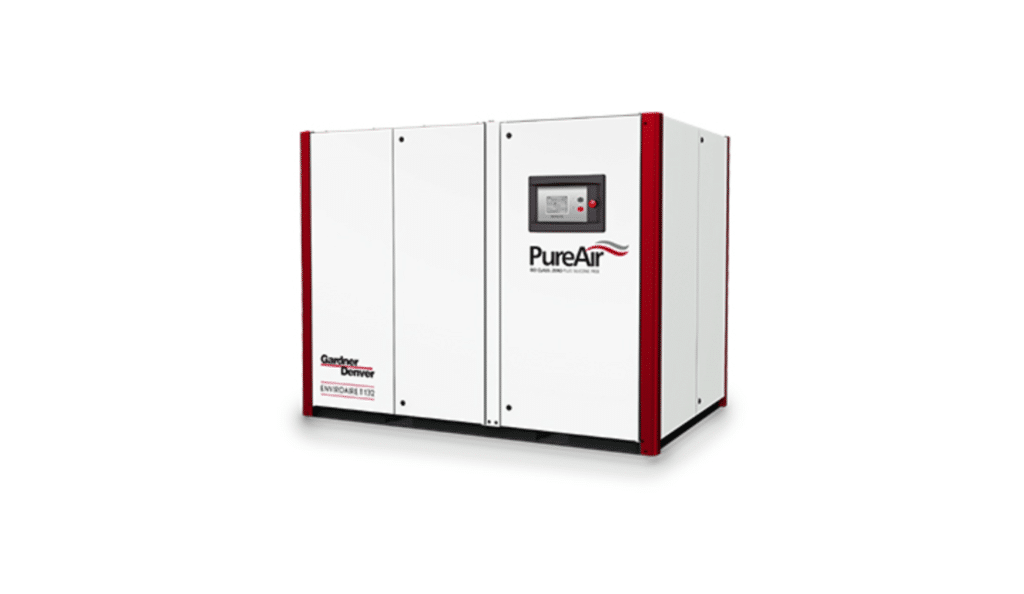C&B Equipment’s Complete Guide to Oil-Free Air Compressors
Oil-free air compressors are widely used in workshops, factories, and other industrial applications. These compressors are popular options when the risk of oil contamination from oil-lubricated air compressors is hazardous or when a certain level of air quality is necessary.
What Is an Oil-Free Air Compressor?
As the name implies, oil-free air compressors don’t use oil on the cylinder walls or the compression chamber. Instead, they are pre-lubricated with a substance, like PTFE or water, that enables internal pistons to slide easily.
Because they are permanently lubricated but oil-free, the pressurized air these compressors produce has a similar quality to the input air. This means it will be free of any moisture or oil vapor.
Oil-free air compressors are the ideal solution for applications in which certain air quality standards are required by the ISO (International Organization for Standardization) or that take place in hazardous environments. These types of compressors are commonly used for sensitive applications, including the following.
- Pharmaceuticals
- Food and beverage processing
- Medical applications like breathing machines
- Semiconductor and electronics manufacturing
- Textile manufacturing
- Automotive spray painting
How Do Oil-Free Air Compressors Work?
Air compressors work simply on the principle of compressing air to the point that the volume increases and pressure decreases. Both oil-injected and oil-free air compressors work the same way, but oil-free air compressors don’t have oil in the compression chamber.
With oil-free compressors, the rotating parts inside the chamber don’t come into contact, which eliminates the need for oil. However, the gears of the compressor are still lubricated in some other way. Here is a brief breakdown of how oil-free air compressors work.
 Step 1: Draw in Air
Step 1: Draw in Air
The first thing the air compressor does is draw in air from the outside of the unit. The air passes through a filter, which keeps debris and dust out. Air passes through a valve to load the compressor, which begins to run once it’s full.
Step 2: Compression
The compression element will compress the air as it moves through the unit. As this happens, it can cause the unit to heat up substantially.
Step 3: Intercooler Cooling
Pistons push the air through an intercooler once it is compressed. The air gets cooled before the unit can do any additional compression. This also reduces the risk of the unit overheating, particularly because there is no oil for lubrication.
Step 4: Secondary Compression
After the air gets cooled, it goes back to the compressor for further compression. This process can also generate more heat.
Step 5: Secondary Cooling
The air gets cooled a second time because it can reach temperatures as high as 150 degrees. The air will pass through a check valve to prevent any backflow inside the machine. Once the air has been sufficiently cooled, it can be released or stored.
Step 6: Monitoring
These units also have a pressure switch monitor to gauge how much air pressure is held in the system. If that pressure drops, the compressor will activate to pressurize the system.
Advantages of Oil-Free Air Compressors
Oil-free air compressors aren’t ideal for all applications. Traditional oil-lubricated compressors work perfectly for applications that won’t be compromised by oil contamination. However, oil-free air compressors offer several advantages over conventional compressors that you may want to consider.
Less Contamination
The main benefit of oil-free air compressors is the absence of oil in the device, which eliminates any contamination of oil in the operations.
Lower Maintenance Costs
When you use an oil-lubricated air compressor, it requires regular maintenance to ensure the proper oil levels are maintained. You don’t have to worry about these upkeep costs with an oil-free compressor.
Reduced Operating Costs
There are fewer moving parts inside an oil-free air compressor, and the initial cost of these units is lower than other types, which can reduce your overall operating costs.
Lighter Weight
Because these types of compressors tend to have fewer internal parts, they might weigh a bit less than oil-lubricated compressors. If you need a portable air compressor, this might be a good choice.
Types of Oil-Free Air Compressors
There are several different types of oil-free air compressors available. Which one you choose will depend on your preferences, needs, and budget. Here are your options.
1. Oil-Free Rotary Screw Air Compressors
With an oil-free rotary screw compressor, the counter-rotating screw elements’ position gets synchronized by the external gears. There is no friction because the rotors don’t come into contact, so there is no lubrication required inside the compression chamber.
2. Oil-Free Piston Compressor
A piston air compressor contains a crankshaft with a connected rod and piston, valve heat, and cylinder. These parts function to produce pressure. An oil-free piston compressor uses Teflon-coated rings for lubrication instead of oil.
3. Oil-Free Scroll Compressor
With a scroll compressor, a single spiral-shaped rotor spins against a similar fixed rotor, which traps air and increases pressure. However, there is no metal-to-metal contact between the spirals, so there isn’t a need for lubrication in the chamber.
4. Oil-Free Rotary Lobe Compressor
This is a type of positive displacement air compressor. It consists of two rotors that intermesh while rotating until the air gets exposed to the discharge port.
Learn More About Oil-Free Air Compressors with C&B Equipment
We hope that this blog post provides you with the information you need, but we encourage you to contact the experts at C&B Equipment if you require further assistance. We offer several types of industrial air compressors, including fixed-speed rotary screw compressors, variable-speed compressors, rotary vane compressors, reciprocating compressors, and of course, oil-free compressors.
Our team of professionals can help you select the correct compressor for your application, and our compressor repair and maintenance services will keep your equipment operating as it should. We have years of experience in the industry and serve clients throughout Missouri, Kansas, Oklahoma, Arkansas, and the Texas Panhandle. We can’t wait to work with you!
